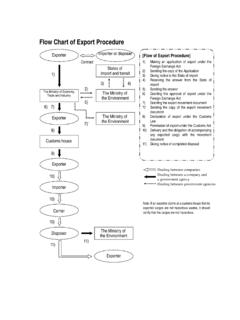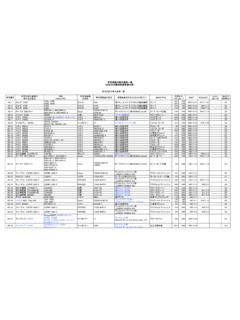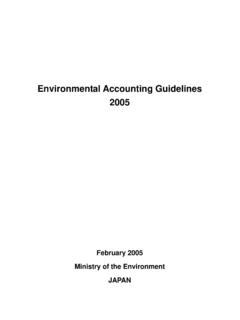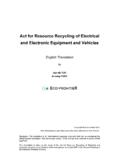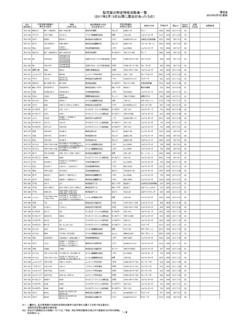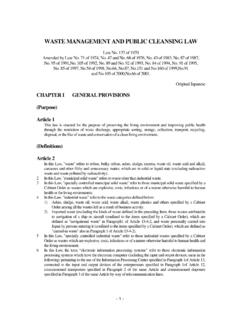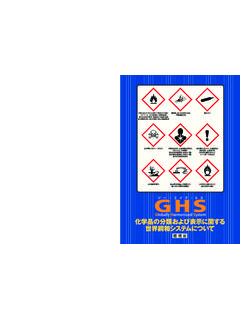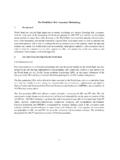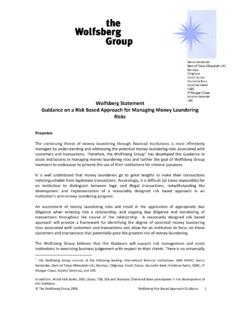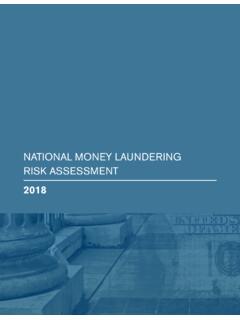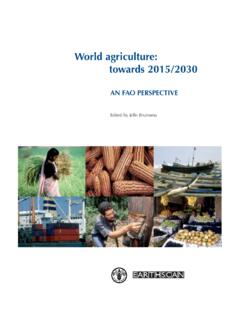Transcription of Approaches to Climate Change Adaptation
1 Approaches to Climate Change Adaptation November 2010 The Committee on Approaches to Climate Change Adaptation List of Members The Committee on Approaches to Climate Change Adaptation Titles omitted Chairperson Nobuo Mimura Professor and Special Assistant to the President, Center for Water Environment Studies, Ibaraki University Hiroshi Ando Manager, Global Warming Countermeasures Section , Department of Environment, Saitama Prefecture Seita Emori Chief of Center for Global Environmental Research (CGER)( Climate Risk assessment Research Section), National Institute for Environmental Studies Takahiro Ochiai Director of Conservation of Water and Soil Division, Forestry and Forest Products Research Institute Kuga Hitoshi Group Leader of Global Warming Countermeasures and Senior Researcher of Recycling Society Division, Nagano nvironmental Conservation Research Institute Mitsuru Tanaka Professor, Hosei School of Policy Sciences Kaoru Nakata General Manager of Marine Productivity Department, National Research Institute of Fisheries Science, Fisheries Research Agency Toshihiro Hasegawa Senior Researcher of Agro-Meteorology Division, National Institute for Agro-Environmental Sciences Yasuaki Hijioka Senior Researcher of Social and Environmental Systems Division (Integrated assessment Section)
2 , National Institute for Environmental Studies Koh-ichi Fujita Research Coordinator for Watershed Management, River Department, National Institute for Land and Infrastructure Management Takao Masumoto Team Leader, Research Team for Global Warming and Environment & Head, Lab. of Hydrology and Water Resources, National Institute for Rural Engineering, National Agriculture and Food Research Organization Approaches to Climate Change Adaptation CONTENTS Summary .. i 1. Background and objectives Background and the need for Adaptation .. Objectives, audience, scope of this report .. 2 2. Approaches and concepts of Adaptation Framework for Adaptation .. Approaches to Adaptation based on current scientific knowledge (1) Types of Adaptation .. 5(2) Fundamentals needed to implement Adaptation measures .. 10 3. Basic factors of Adaptation common to all sectors Factors in considering Adaptation (1) Latest knowledge on Climate Change .
3 14(2) Short-, medium- and long-term risk management in the face of uncertainty .. 17(3) Consideration of regional characteristics .. 19 Specific procedures for Adaptation planning and implementation .. 20A Track. Detailed planning and implementation steps Step (1) Analyze past observation data, review responses (including existing measures) to Climate Change and extreme weather events .. 22 Step (2) Plan and Implement monitoring of Climate Change and its impacts .. 22 Step (3) Project future Climate Change and its impacts .. 26 Step (4) Assess impacts, vulnerability, resilience, and risk .. 30 Step (5) Determine need for Adaptation measures, determine priority .. 40 Step (6) Design and implement Adaptation measures .. 45 Step (7) Track and assess progress and effects of Adaptation policies measures, revise regularly .. 55 Step (8) Conduct integrated Adaptation , basic capacity enhancement.
4 57 Step (9) Communicate and share information with the public .. 58 Step (10) Review and implement based on feedback and re- assessment .. 58B Track. Simplified first five steps for Adaptation planning and implementation .. 59 Step 1 Share knowledge and Approaches to Adaptation , and examine existing measures .. 61 Step 2 Assess risks associated with Climate Change impacts .. 61 Step 3 Promote communication and decide Adaptation plans, programs, and measures .. 62 Step 4 Start with the most feasible initiatives .. 62 Step 5 Consolidate risk assessments and Adaptation measures based on monitoring and the latest knowledge .. 62 Approaches to incorporate Adaptation into plans, programs and policies (1) Use diverse options, including soft and hard measures .. 64(2) Create synergies and prevent adverse socioeconomic and other impacts.
5 68(3) Integrate Adaptation measures .. 70 i Summary Audience and objectives of this report This report is mainly for national and local government departments responsible for Adaptation to Climate Change . It summarizes basic Approaches common to multiple sectors, with the following three objectives: (1) to indicate various Approaches to Adaptation , based on the latest scientific knowledge and consideration of uncertainty; (2) to indicate the basic factors of Adaptation common to all sectors, relating to the consideration, planning, and implementation of Adaptation measures; and (3) to raise awareness about Adaptation and its necessity. Approaches to Adaptation based on latest scientific knowledge Short-term Adaptation : It is essential to initiate and encourage urgent response measures to prevent or mitigate short-term impacts that are already occurring and likely to arise from Climate Change .
6 Medium- and long-term Adaptation : Response measures are necessary to enhance adaptive capacity to prevent and mitigate possible impacts, by assessing the risks of impacts that may occur in the medium and long term, and by controlling the impacts, reducing vulnerability, and strengthening resilience. Adaptation measures in individual sectors: These are measures implemented with the intention of adapting to estimated impacts in specific sectors. Even in sectoral Adaptation , it is essential to evaluate the risk-reduction effects, costs, and other relevant factors comprehensively. ( , new construction and functional improvements of embankments to cope with sea level rise and storm surges, soft (non-structural) measures such as improvements in tsunami and storm surge hazard maps, and strengthening of measures to prevent outbreaks of infectious diseases such as dengue fever.)
7 Integrated Adaptation and basic capacity enhancement: These Approaches include integration of measures planned on a sectoral basis to a unified and effective Adaptation plan, and enhancement of basic capacities of localities and sectors such as technologies and human resources. These should be implemented with a systematic and long-term perspective. ( , the identification of issues that require cross-sectoral Approaches .) ii Awareness-raising (improvement of enabling conditions): It is of fundamental importance to raise the awareness and understanding of the people and government agencies responsible for Adaptation . It is also important to identify the responsibilities, roles and collaborations among organizations both at national and local levels. These efforts should be initiated and promoted as quickly as possible.
8 Information consolidation (improvement of enabling conditions): Institutional arrangements and methodology development for gathering, managing, and utilizing basic information on the target areas and sectors are the basis for planning and implementation of Adaptation measures. These efforts should be initiated and promoted as quickly as possible. Research and technology development: Research and technology development should be promoted in such areas as monitoring and projections of Climate Change , measures for the short-term, and the medium- and long-term Adaptation effective to improve the resilience of local societies. Basic Factors of Adaptation Common to All Sectors At the initial stage of Adaptation planning and implementation, the following points deserve special attention.
9 As the impacts of Climate Change are already occurring, it is urgent to strengthen existing response measures in individual sectors and take short-term Adaptation measures. In parallel with this, it is essential to start planning the medium- and long-term Adaptation measures, while assessing the future risks of Climate Change based on the latest scientific research. Effectively utilize existing information at the initial stage of assessing the risk of Climate Change impacts. Publish the results of risk assessments at an early stage, and broadly share awareness of those risks . Within government agencies, establish structures to promote Adaptation , and give adequate priority to Adaptation within policies, plans and programs. It is essential to initiate urgent efforts to prevent and/or mitigate short-term impacts, and also to give higher consideration to measures where socioeconomic benefits are clearly superior in terms of cost ( , no-regrets and win-win Adaptation measures).
10 Iii Steps for Adaptation Planning and Implementation This report presents two tracks of steps for the planning and implementation of Adaptation measures. The first is a set of standard steps that should be conducted in any case. These are steps that can be implemented if a certain amount of information has already been compiled on Climate Change and its local impacts ( A-track steps for planning and implementation of Adaptation measures). Many local governments, however, are not ready to apply those steps directly. Therefore, it provides a second set of steps easy for those who consider Adaptation measures for the first time. These consist of steps simplified from the A-track , to facilitate initial efforts for Adaptation measures utilizing currently available information ( B-track of the first five steps).
